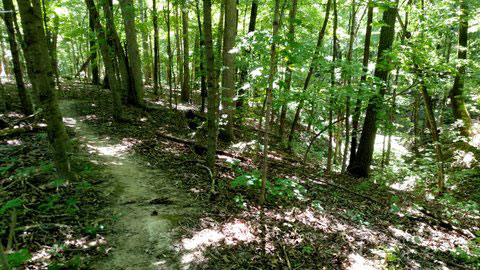Worksite info
Woodyard Conservation Area

Woodyard Memorial Conservation Area protects 205 acres of forest, hill prairie and river. The 36-acre Waterworks Hill Prairie, recognized by the Illinois Natural History Survey as a high-quality glacial drift hill prairie, is the largest and best glacial drift hill prairie remaining along the Embarras River. The 136-acre woodland tract contains upland woods with steep slopes and deep ravines, flooded ravine/wetland habitat and lake shore frontage on Lake Charleston. The 36-acre river tract has nearly a half mile of frontage along the Embarras River, which is recognized as a biologically significant stream that provides important habitat for a least 5 species of state threatened or endangered fish and mussels. The City of Charleston acquired the entire area in 2003 through a gift from Dorothy Woodyard combined with a Conservation 2000 grant from the State of Illinois. The area enjoys long-term protection as a Land and Water Reserve.
The hill prairie is the last of nine hill prairies in the area that were mapped in the early 1900s, the others having been degraded by woody encroachment or development. It boasts over 100 native grasses and wildflowers including big bluestem, Indian grass, hoary puccoon, rough blazing star, prairie dock, purple milkweed, false boneset, white wild indigo and New Jersey tea. The Embarras Volunteer Stewards have worked for several years at the site to remove woody plants, especially non-native burning bush, so as to allow light for the native grasses and wildflowers.
The forest is primarily mature second or third growth dry mesic, mesic-upland and some wet-mesic upland forest. Dominant trees are white oak, shagbark hickory, white ask, shadbush, hop hornbeam and, on lower slopes, sugar maple, red oak, basswood, butternut hickory, blue beech and paw paw. Wildflowers include false hellebore, woodland phlox, large flowered bellwort, spikenard, maidenhair fern, fragile fern and broad beech fern.
The floodplain forest portion, along the south side of Route 130, contains silver maple, hackberry, sycamore, cottonwood and green ash, as well as herbaceous plants such as false nettle, white grass, silky and Virginia wild rye, golden glow and wood nettle. This segment of the Embarras River is a highly valued mussel resource. Fourteen species of live mussel have been found here, including threeridge, Wabash pigtoe, plain pocketbook, yellow sandshell, white heelsplitter, fragile papershell, pink heelsplitter, pink papershell, giant floater, pimpleback, mapleleaf, pistolgrip, fawnsfoot and deertoe.